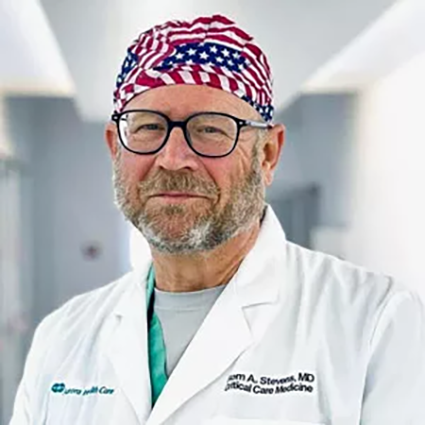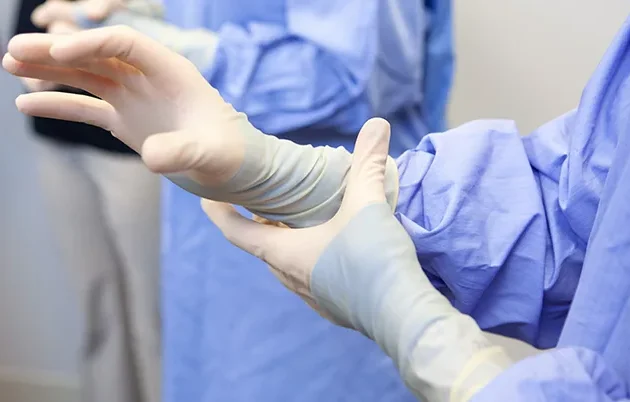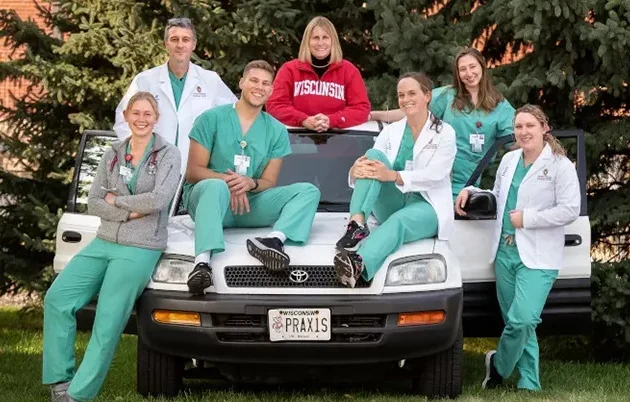The complex yet melodic Ukrainian language lends itself to a rich tradition of poetry and folk music, to which we were exposed daily. Each night in our hotel room, we studied the language using an online course. Gradually, we could read signs and form basic sentences, with much help from our Ukrainian friends.
L’viv was well-patrolled by civilian and military police of the Territorial Defense Force, equivalent to the U.S. National Guard. The soldiers and police we met were professional, well-equipped, uniformed and attentive to security threats. However, the entire country is a war zone. Approximately three times per week, Russian cruise missiles were fired in the direction of L’viv. There had been civilian casualties from these strikes early in the war, but we were not aware of any local casualties during our time in the city. However, each week L’viv hospitals received many casualties via train from hospitals near the Donbas front in eastern Ukraine.
Dr. Kerr and I gave more than 25 lectures and workshops on topics such as massive transfusion, whole-blood transfusion, mechanical ventilation, chest X-ray interpretation, North Atlantic Treaty Organization (NATO) military medical organization and point-of-care ultrasonography. We worked in the operating rooms and intensive care units (ICUs). Dr. Kerr took the lead in identifying funding from charitable sources and was able to purchase and see delivery of an anesthesia machine, blood warmers and body-warming devices. All the hospitals we visited had severe shortages of medications, including anesthetics and antibiotics. These were mitigated to some degree by pharmaceutical donations from many countries of the European Union (EU).
The L’viv Emergency Hospital is planning to build a national rehabilitation center and bone marrow transplant center. City Hospital #8 is building a new burn ICU. Both are multi-year projects that will require massive external funding because the Ukrainian medical system is severely underfunded and understaffed; it would require much-improved salaries for the professional staff, as well as the addition of many more nurses and physical and occupational therapists, to bring the health care system up to Western European standards.
Despite our language challenges, we made many friends among the doctors, nurses, physical therapists and hospital administrators in L’viv. We fell in love with this beautiful city with a rich history and many historical buildings and parks. We developed a deep admiration for the bravery and strength of the Ukrainian people as they defend their language, culture, religion and choice of a democratically elected government.
Shortly after we departed L’viv, the EU accepted Ukraine and Moldova as candidate members. Ukrainians strive to be part of Europe and never again part of Russia. All the Ukrainians we met expressed sincere appreciation for the support of their country by member states of NATO, the EU, Australia, New Zealand and Japan. I think our most important contribution to the L’viv medical community was our presence that demonstrated the United States stands with Ukraine in the defense of democracy.
We are working with specialty societies to find additional funding for Ukrainian hospitals and to get our Ukrainian colleagues the ability to access English-language specialty journals, which are unaffordable to most doctors there. Dr. Kerr and I also are working to obtain and ship current anesthesiology and critical care medicine textbooks to the First L’viv Medical Union. Many physicians we met feel they would benefit from courses in advanced trauma life support, point-of-care ultrasonography and fundamentals of critical care support. Providing such courses in Ukraine will require coordination with our specialty societies. Finally, we learned that the Danylo Halytsky National Medical University in L’viv would be interested in developing a long-term relationship with a U.S. medical school.
Dr. Kerr and I found it difficult to leave Ukraine at the end of our two months there. I look forward to returning to L’viv and to our friends and colleagues who are struggling to care for victims of war while they also defend their country and work to improve their medical education and health care systems.
About the author:
Captain Rom A. Stevens, MD ’82, U.S. Navy (retired), is a professor of anesthesiology and medicine at the Rosalind Franklin University of Medicine and Sciences in North Chicago, Illinois. An anesthesiologist and intensivist, he works for Advocate Aurora Health in the Chicago area. He serves on the Wisconsin Medical Alumni Association Board of Directors. His colleague, Captain Robert Kerr, MD, U.S. Navy (retired), is board-certified in internal medicine and emergency medicine. He lives and works in Spokane, Washington.


